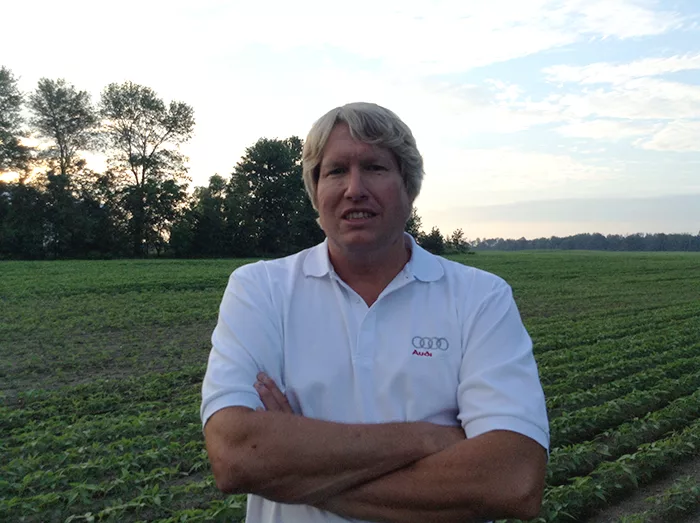Steve Twynstra likes things documented. “I am a numbers person. I learned in my graduate work that if you can’t measure it, you can’t manage it,” he says.
 In his desire to grow the family’s 3,000-acre farm operation in Ailsa Craig, Ont., he became interested in precision farming equipment he started seeing at farm shows in the mid-’90s.
In his desire to grow the family’s 3,000-acre farm operation in Ailsa Craig, Ont., he became interested in precision farming equipment he started seeing at farm shows in the mid-’90s.
In 1998, he invested in a Lite Star II section control system from Sitewinder GPS Inc. for his sprayer. “It was a GPS-assisted steering system with full section control and record-keeping functionality,” Twynstra says. “Originally I used it in a John Deere 7410 tractor with our FMC pull-type sprayer until we upgraded to the Deere 4720 self-propelled sprayer in 2007.
“The auto-steer system worked great, but we were limited to 10-14 mph in the self-propelled sprayer so we upgraded to an Outback S3 with EDrive TC, which used the same box as the older unit.
They have since upgraded to the Outback Max with EDrive X, and the sprayer was upgraded to a 120 foot boom to match the two 60 foot Bauer planter frames. They plant corn on 30 inch row spacings or interplant 15 inch dry bean or soybean rows as well as match the 40 foot air seeder for wheat.
The planters can variable-rate seed and fertilizer using a GreenStar 2630 monitor, which is also used to guide wheat seeding with his 60 foot air seeder. “We are trying to control traffic, so matching up the equipment sizes is important to us,” he says.
Twynstra extended the sprayer boom to 120 feet to match the other equipment widths, but found the Raven 2 controller couldn’t maintain boom height.
“We then upgraded to a five-section Norac UC5 auto boom height controller with severe terrain option to work with the Outback model,” he says. “We could travel at 12 mph instead of 6 mph. It’sawesome and takes another display out of the cab.”
What Farmers Want From You is a series of farmer profiles that examine the scope of precision farming tools individual farmers are using on their operation, along with the frustrations that can occur with adopting new technology and how dealers can alleviate those "points of pain" for farm customers. For the latest additions to the series, visit our What Farmers Want From You feed.
However, they had some initial problems with the connection. “We were only the second farm to try this and the cabling the dealer sent was built for a 4710, not a 4720,” Twynstra says. “We had the dealer fix the cabling issues and now it works great.”
Using conventional tillage practices on most of his corn and soybean acres, Twynstra uses a StarFire 2 signal to guide his equipment. He will variable-rate seed corn and soybeans, depending on the soil type variability in the field, as well as the data he has available to make management decisions. He is looking into variable-rate dry and edible bean seeding to reduce seed costs.
Because his fields are rather flat, the GPS signal only requires slight adjustment by the operator to stay on the row. “We think the SF2 signal is good enough, even though our Deere dealer has an RTK signal we could use,” Twynstra says. “We farm up to 60 miles away doing some custom farm work, so setting up a base station that far away from home isn’t worth the added signal accuracy.”
Point of Pain: High Demand for Experts
Twynstra’s precision farming system, even though it spans several precision farming brands, uses SMS management software to manipulate data and develop prescriptions. Twynstra says it’s essential to have experts available to help make sense of the data and use it.
“With these systems, you need to have someone available who knows them inside and out,” he says. “While I am pretty good at working with the platform and transferring the data, I meet with our GIS person about once a year to go over how we might be able to make our systems better. That person has to know this equipment inside and out so we can get the best value from it.”
The GIS expert helped Twynstra use the collected data to show custom farm customers what was done, when and where. “Our seed customers also bring over their customers — some from as far away as Asia — to see the documentation. They like knowing what was applied and seeing the results.”




![[Technology Corner] A Big Step Forward for Interoperability & Data Sharing](https://www.precisionfarmingdealer.com/ext/resources/2025/12/12/A-Big-Step-Forward-for-Interoperability--Data-Sharing.webp?height=290&t=1765565632&width=400)


